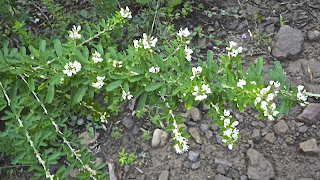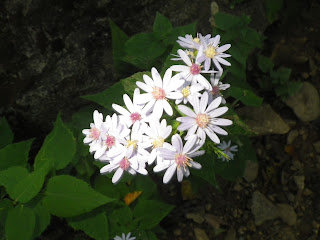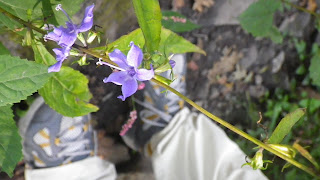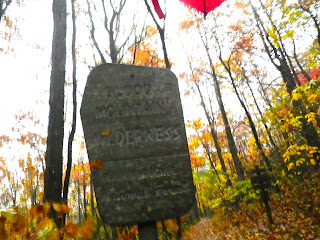Appalachian Trail Wild Flowers and Selected Plants
There are many plants found on and around the Appalachian Trail. The following photos are a small representative of them. Because of the ecology, the trail may be considered a deciduous tree forest. There are many insects and birds that aid in the production of plant species. For example, bees and other flying insects help pollinate flowers and, many birds eat the plant seeds in one area and later "poop out" in another area.
This flower, known as Smooth Gerardia, Gerard laevigata, is found in dry woods among oak trees, usually from July to September. It is a bright yellow funnel or bell shaped flower about one to one and a half inches long. It is called "false yellow foxglove" and it is fairly common in the southern mountains.
The Spring Beauty . Clayton Virginica, has white to pink flowers with deeper pink veins. These flowers are first to show up during the spring and only last for about three days. Deer and moose as well as chipmunks, mice, and people have found the roots to be quite delectable and nutritious. When eaten raw the roots taste like radishes and when cooked taste like potatoes.
Chinese clover, Sericea lesoedeza, is a perennial legume. It is herbaceous with a woody stem. A small cluster of flowers is located on a branched stem, on the average it grows with a three feet tall stem surrounded by small leaflets. It flowers from July to October and is used for erosion control and feed.
Although hardwoods predominate the trail one will also see evergreens of pines growing in the background. The white pine, Pinus strobes, has needles for leaves clustered in bundles of five, shaped like a "W." It grows in dry, higher elevations and rocky ridges.
The Virginia pine, Pinus virginiana, is found in large numbers in the upper Coastal Plain and hilly areas of Virginia and surrounding states. The needles grow in bundles of two and form a "V." They vary from one and a half to three inches in length.
The sugar maple, Acer saccharin, is often called the sugar tree and is found in the cool slopes in the mountains. It is usually a slow growing tree forming a dense crown for heavy shade. The leaves are three to five inches across, pointed and with sparsely toothed lobes. These leaves are responsible for the bright red colors in the fall.
Mountain laurel, Kalmia latifolia,is found in the wooded areas around rocky or sandy soils from New Brunswick to Ontario and south to Florida and Louisiana. It has a very beautiful flower but is poisonous and should not be used for cooking. It grows three to fifteen feet high.
Hair cap moss, Polatrichum commune, gets its name from hairs that cover a cap where each spore case is held. It has a star shaped appearance because of the way the leaves are shaped on the stem. It grows four to twenty centimeters tall. The average life span is five years. It lives in lightly shaded areas with moist acidic soil and sometimes in full sunlight. It grows wild from granite outcropping to the coastal plain. It is used by some people to make a tea to dissolve kidney and gall bladder stones. It is also believed by some to be good for the hair as a rinse to straighten hair. In the past it has been woven to make baskets.
Wild geranium, Geranium maculatum, has lavender flowers with five petals (sepals) with deeply forked leaves. It can be found in wood thickets and meadows. It flowers April through June.
The fire pink, Silene virginica, has bright red long-stalked flowers in loose clusters at the top of a slender stem. The flowers have five petals that bloom in April through June. A common name is catch fly because of the sticky hairs that trap insects.
The rue anemone, Anemonella thalictroides, flower has three leaves, each with three lobes, that form a whorl on the stem below the flower cluster of this six to eight inches plant. The flowers are white to pinkish with five to ten petal-like sepals. The flowers bloom from April through June. It is found in open wooded areas.

The large-flowered trillium, Trillium grandiflorum, grows eight inches to eighteen inches tall. The color of the flowers ranges from white to deep pink. It grows in rich foods and often in coves and on slopes. The trillium goes through a long process to bloom. The flower becomes pollinated and develops a berrylike fruit. The seeds inside the fruit enlarge, and the fruit breaks open and fall to the ground on fertile soil. The seeds are carried underground by ants where they spend two years, and then they break the surface and continue to grow for four more years developing leaves. After a minimum of six years from the time the seeds touched the ground, a blossom will appear and the plant will continue to produce flowers for many seasons. It blooms April through June.

White snakeroot, Eupatorium rugosum, has heart-shaped or triangular leaves and is very common in rich woodlands at high altitudes with snow-white flowers clustering August and September. The plant has coarsely toothed-shaped leaves on a slender stem. There have been some fatal cases of "milk-sickness" in man and cows that have been traced to the use of milk from cows that had eaten white snake.
The small flowers on the white aster, Aster vimineus, are August through October in dry to moist fields and meadows to shores. It grows two to five feet tall. The flower head is about a third inch wide and is arrayed in groups of fifteen to thirty.
Lady's thumb, Polygonum persicaria, is made up of dense erect, oblong or cylindrical spikes of small pink or purplish flowers at the tops of simple stems. The flower clusters are four mm long to two inches long. There are no petals but the sepals are four to six and colored. The fruit are seed like and glossy black. It flowers in June through October alongside roads, damp clearings, and cultivated ground.
Tall bellflower, Campanula americana, has a stem one to four feet in length. The one inch flower has five light blue petals in a star shaped pattern. It flowers June through September. It is found in moist woods and on open slopes off the Blue Ridge Parkway and in the Great Smoky Mountains National Park.
Crested dwarf iris, Iris cristata, was named by the Greeks for their goddess of the rainbow. It prefers wooded slopes and ravines. The pale to deep purple flowers are divided into parts. The three petals are narrow and arching, and the three petal-like sepals are broader, curved downward. It is streaked with purple and are crested with white to yellow ridges. It blooms from April to May.
Pale jewel weed, Impatiens pallia, flowers are a yellow coloration and side-turned sepal spur divided into two parts. Because of its fruit it is also called snapweed and touch-me-not. The seeds mature inside a coiled capsule and when ripe explode out of the capsule when touched. Some people believe the sap of this plant will ease poison ivy itch. It is found in moist woods, gaps, and coves. It blooms from June through September.
Rock tripe lichen, is found growing on the rocks throughout the trail. Lichen is a combination of an algae and a fungus. The fungus aids in anchoring the algae to the rock and the algae helps provide nourishment for the fungus. In a survival situation you can eat the lichen after a series of boiling and water changing. It might be a little on the chewy side.
Bloodroot, Sanguinaria canadensis, is usually two to eight inches tall, with one leaf usually folded around the stem. The majority of the plant is found underground, and that is why it is called bloodroot. The plant may be poisonous if eaten. It is a skin irritant to some people.
Sassafras, Sassafras albidium, is a small aromatic tree usually not over forty feet in height an a foot in diameter. It is common in dry soils and is the first to repopulate abandoned fields. The seeds are spread by birds. There are three different leaves on the tree -- a three lobed, single lobed, and a dual lobed. The wood was originally used for posts, rails, and boat-building.The oil from the bark and roots was used to flavor candles.
The mountain maple is really an ash tree but the leaves resemble a large maple leaf. It was originally classified as a maple but later reclassified as an ash. It is very unique because it has long longitudinal white stripes leading up the plant stem. You may see this tree often along the trail.
The galax, Galax aphylla, is ten to twenty-four inches tall with heart-shaped shiny leaves. It is found June through July, but you have to be very observant to find it along the trail. It may be found in open woods and rocky slopes.
The tulip poplar, Liriodendron tulipifera, is better known as the tulip tree or yellow poplar. It has a yellowish flower as well as the heartwood of the tree. It is one of the largest and most valuable hardwood trees. It grows in deep moist soils usually along streams and the lower mountain coves. Trees may grow from sixty to one hundred feet tall and three to four feet in diameter. Bees are known to make honey from their very large flowers. The wood is cut into lumber and used for veneers and furniture.
Ferns like the Christmas fern, Polystichum acrostichoides, grow to a height of one to two feet and spread one to two feet. They are non-flowering and grow in part shade to full sun. The soils may have dry to medium water content. The leaves are long green blades with many leaflets shaped like Santa's boots. This is one of the only plants that tolerate rabbit, deer, drought, heavy shade, erosion, and shallow rocky soils.
Poison ivy, Toxicodendron radicals, leaves are all in groups of three on the stem or vine. The leaves are often shiny and green, the vines are covered with hairs. They bloom in May through June. All parts of the plant are poisonous and touching causes severe, weeping rashes on people who are sensitive to the plant oils.
Fringed polygala or gaywings, Polygala paucifolia, with three-quarter inch reddish or purple flower has a center tube and two tubes perpendicular to the center tube. It blooms in April through June. They thrive in woods with acid soils and small colonies up to elevations of 2,500 feet. These flowers were once considered as members of the milk wort family and believed to be able to stimulate the increase of milk in cows, hence the scientific Greek name poly and gala or much milk.
Jerusalem artichoke, Helianthus tuberosus, the toothed egg-shaped upper leaves are alternate and the lower leaves are opposite on the stem. The flower is yellow and blooms in August thru October. The plant does not come from Jerusalem and is not in the artichoke family. The Native Americans and colonists ate the tuber of this plant, it sometimes can be found in supermarkets.
The red maple, Acer rubrum, is a medium sized tree--quick growing and relatively short--lived. It is used as a shade tree but is inferior to other maple trees. The bark is smooth and light to dark gray in color. The normally green leaves turn bright red in the fall. The fruit consists of pairs of winged seeds about one half to one inch long. The wood is a soft close--grained and rather weak light brown. It is used to manufacture furniture, wooden ware, and for fuel.

Columbine, Aquilegia canadensis, reminded people of a flock of hovering birds and so it earned the Latin name columba or "dove." The flowers long curved spurs resembled an eagle's talons or Aquilegia Latin for eagle. Bees just nip the flower tip to drain the nectar out and hummingbirds love these flowers, as well. It was believed that juice from a fresh flower was used to reduce a swollen liver from jaundice or to cure measles or small pox. The plant may have a soothing effect on pain. It blooms from April thru July. The flower may be red or yellow.
Virginia spring beauty, Clayton virginica, has two long lanceolate leaves opposite each other on the stem. The one--half inch five petal flowers are white with pink lines. It blooms from March through May and is found in moist wooded areas. The flowers only last three days. Deer and moose browse on the tiny flowers, but humans and small animals like to eat the roots. The roots taste like radishes when raw and like potatoes when cooked.

Star chickweed, Stellaria puberal, is known for its white flower but is valued by birds,animals, and humans. Birds find its seeds to be quite delectable so it is also known as birdseed. Grazing animals are drawn to it because the plant is a source of copper. European markets sell it because it is considered a very tender edible green and is added to many salads. It is also high in vitamins A and C--helpful treatment for scurvy. It has also been known as a poultice for abscesses and boils. According to folklore the sun will be shining bright if the blossoms are spread out to their fullest. If the flower begins to close that means rain is coming.
PSALMS 103:15--As for man, his days are as grass: as a flower of the field, so he flourisheth.




















































